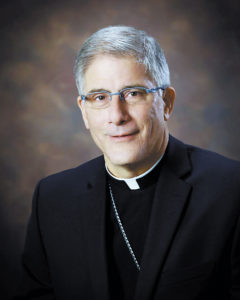
Bishop Joseph Kopacz
By Bishop Joseph Kopacz
As part of our Lenten journey, we welcomed to the Diocese of Jackson the relics of Saint Padre Pio as they travel on their inaugural pilgrimage through the United States thanks to the Foundation for Saint Padre Pio. I was uncertain about his standing among the Communion of Saints here in Mississippi and throughout the South, but the response was inspiring in the number of people who came to the Cathedral for the two Masses on Thursday, March 1, and throughout the day.
In the Northeast of the United States there are many who have a devotion to him, asking his intercession to face the suffering and struggles of life. He has led many to Jesus Christ, especially since his canonization by Pope Saint John Paul II on May 2, 1999, as the third millennium dawned.
Speaking to the pilgrims in Saint Peter’s Square on the day after his canonization, Saint John Paul II extolled the signature holiness of Saint Padre Pio. “Dear brothers and sisters, Padre Pio’s witness is a powerful call to the supernatural dimension, not to be confused with exaggerated concern for miracles, a deviation which he always and resolutely shunned. Priests and consecrated persons in particular should look to him. He teaches priests to become the docile and generous instruments of Divine grace, which heals people at the root of their ills, restoring peace of heart to them. The altar and the confessional were the two focal points of his life. The charismatic intensity with which he celebrated the divine mysteries is a very salutary witness, to shake priests from the temptation of habit and help them rediscover, day by day, the inexhaustible treasure of spiritual, moral and social renewal which is placed in their hands.”
For many years Padre Pio spent more than half of his day in the confessional, a herculean witness to the mercy of God that was pure gift. Even the most zealous of priests would be overwhelmed by this relentless commitment. He followed in the footsteps of Saint John Vianney who was also a stellar instrument of God’s forgiveness and reconciliation, and was a contemporary of Saint Sister Faustina, an instrument of Divine Mercy.
The Eucharist, the table of Word and Sacrament, and the Sacrament of Reconciliation remain the royal roads for repentance and reconciliation in the Church in the modern world. Recall, that one of our pastoral priorities is to be “welcoming and reconciling communities,” with repentance as an ever pressing demand of the Lord in order to accomplish his will in our lives and in our world. If we are honest, sometimes the Churches falls short and the cry for repentance and reconciliation must be proclaimed and heard in the world. One striking example is rumbling around our country at this time.
After the most recent mass shooting and carnage in Marjory Stoneman Douglas High School in Parkland, Florida, students launched a new campaign to raise awareness about the horrors of gun violence. Students are harnessing and focusing their deeply felt grief and anger against the indifference and intransigence that pervades American society regarding an honest reappraisal of the Second Amendment of the Constitution. Reflecting back on last Sunday’s scripture from the Gospel of John, in which Jesus revealed God’s righteous anger over the the scandalous activity in the Temple in Jerusalem, might prompt us to hear the cry of the righteous anger of our young people and their supporters over the outrage of mowed down friends and students in their school.
God’s house of prayer, the point of union between heaven and earth, had become a market place, and business as usual prevailed. So too our young people are overturning the canned rhetoric of our politicians and the gun lobby with the hope of bringing about genuine dialogue that can lead the nation to sanity and greater security.
On the other hand, here is an example where the Church is failing miserably. The “Sanctuary Church” in Newfoundland, Pennsylvania, invited their members to bring their AR-15 rifles to a church service for a celebration of the “rod of iron.” Here is the news clip. Sanctuary Church in Newfoundland, NEWFOUNDLAND, Pa. — A Pennsylvania school district will cancel classes at an elementary school on Wednesday because a church down the street is hosting a ceremony featuring AR-15 rifles. World Peace and Unification Sanctuary in Newfoundland believes the AR-15 symbolizes the “rod of iron” in the biblical book of Revelation, and it is encouraging couples to bring the weapons to a commitment ceremony.”
You can search the story online to see the extent of this lunacy. In this instance the Spirit of God is evident in the world and not in the Church. Our nation needs a greater commitment to the common good, a rational stance regarding rights, responsibilities and limitations. In the aftermath of Parkland, Florida perhaps it may be our young people who guide us to our senses. At the deepest level this is all about repentance, reconciliation and bridge-building among opposing factions in our nation. This is the foolishness of the Cross, the wisdom of God, that has the potential to flower in our nation in the face of tragic loss.
The Ash Wednesday mandate of the Lord is our compass during these forty days of Lent, and I encourage the Sacrament of Reconciliation during the time leading to Holy Week. I exhort especially our parish communities and schools to see themselves as ambassadors for Christ and ministers of reconciliation for the renewal of our diocese and as a leaven for our communities, state and nation. As the Baptism Ritual proclaims. “This is our faith, this is the faith of the Church; we are proud to profess it in Christ Jesus, our Lord.” Saint Padre Pio would shout out his approval from his place in heaven.

